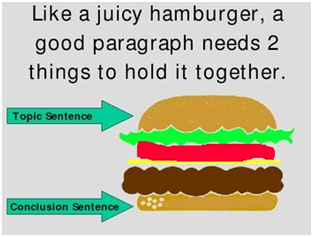
Lesson 2: A Review on Basic Structures
In this lesson, we’ll be reviewing the different parts that make up your basic paragraph.
Objectives:
- To refresh one’s memory with regard to the basic structures involved in writing
- To clearly define what certain structures should contain
- To provide examples of these structures
Quick Navigation through the Lesson 2:
We’ll begin this class with the basic structures involved in writing—in this lesson, we’ll be taking a refresher as to the different parts of a paragraph. We’ll talk about what these parts contain and how mastering these tools will be the building blocks of your writing skills. Outlined below are the different structures that you’ll encounter throughout this course along with brief definitions and examples that will help you better understand how these basic elements are incorporated into writing.
Sentence
We can define the sentence as the largest independent unit of grammar and the smallest independent unit of composition. It’s made up of words and usually contains at least one complete thought. There are four basic types of sentences: the simple sentence, the compound sentence, the complex sentence and the compound-complex sentence. These are discussed below; examples are also provided for each type of sentence to help you better understand how each type of sentence is used.
The simple sentence is one that is composed of one complete thought and one independent clause or group of words that can stand alone. Simple sentences don’t have any dependent clauses or words which can’t make sense by themselves.
For example:
Jenny loves cake.
The compound sentence is one that is composed of two independent clauses with two different complete thoughts joined together by a conjunction or connector (e.g. and, or, but). These also don’t contain any dependent clauses (minus the conjunction).
For example:
Jenny loves cake and Martha likes baking.
The complex sentence is one that is composed of one independent clause and at least one dependent clause.
For example:
(Note: the dependent clauses are underlined.)
Jenny loves cake and coffee in the morning.
The compound-complex sentence is one that is composed of at least two independent clauses and at least one dependent clause.
For example:
(Note: the dependent clauses are underlined.)
Jenny loves cake and Martha likes baking but their parents don’t like sweets.
Paragraph
 A paragraph is the basic unit of composition in most languages. It is composed of several sentences that are usually grouped together because they’re about a certain subject. A paragraph contains three kinds of sentences which we’ll be discussing in the next few points—topic sentences, supporting sentences and concluding sentences.
A paragraph is the basic unit of composition in most languages. It is composed of several sentences that are usually grouped together because they’re about a certain subject. A paragraph contains three kinds of sentences which we’ll be discussing in the next few points—topic sentences, supporting sentences and concluding sentences.
A typical paragraph contains five to seven sentences. In academic papers, the first sentence of a paragraph is usually indented—although this convention can be waived, depending on the kind of document you’re writing. Below is an example of a paragraph:
One of the biggest controversies in the world of cartography or the study of maps was the plagiarism of maps that occurred as a result of poverty in the post-World War I years. Map-makers were able to get over this by making up different towns on their maps. This way they would know if their map was plagiarized because that point they’d made up specifically for their map (a point that didn’t exist in real life) was on the other manufacturer’s map, thus implying that their map had been copied or drawn. This allowed map makers to sue plagiarizers; oddly enough, the money made for these cases funded most of the cartography industry as we know it. This allowed map-makers to sustain their trade despite a number of setbacks which came about as a result of changes and discoveries made pertaining to the Earth’s surface.
(Note: see how all the sentences above talk about the map plagiarism controversy that occurred after World War I.)
[WpProQuiz 194]
Topic Sentences
A topic sentence is typically the first sentence of your paragraph (although this is not always necessarily the case). It is usually the most general sentence in the paragraph and allows your reader to find out what the paragraph is talking about. In our example above, the first sentence is the topic sentence (it is underlined). It contains the subject in a nutshell.
Supporting Sentences
Supporting sentences make up the rest of the paragraph—these sentences are meant to support your topic sentence. They are typically between your supporting statement and your concluding sentence; this makes up most of the body of your sentences. Also, these provide the readers with facts about your subject or (when applicable) basis for your argument. In the example above, these are the sentences before the last sentence.
Concluding Sentences
Concluding sentences are found at the end of a paragraph. They either contain a conclusion or insight about the subject (as in our example above, which is marked in boldface type) or else provide a transition from the current paragraph into the next one.
In this lesson, we were able to discuss the different basic parts of a paragraph as well as the definition of the paragraph itself. We were able to learn about the different types of sentences and how they each play a significant role in the composition of paragraphs.
[WpProQuiz 195]
Now that we’ve refreshed our memories of the basic structures of paragraphs and composition, we can move onto our next lesson. In this next part of our class we’ll be reviewing the different basic elements that we can refine to help boost our writing skills. Keep reading and we’ll be moving onto our lesson about the different kinds of paragraphs that we’ll encounter when writing.
 + 1-888-827-0150
+ 1-888-827-0150 + 44-20-3006-2750
+ 44-20-3006-2750










